Pew Research Center revises report about 'racial conspiracy theories' after backlash
The Pew Research Center has revised a report after it received criticism for saying a majority of Black Americans believe “racial conspiracy theories” about U.S. institutions.
In the report released June 10 titled “Most Black Americans Believe Racial Conspiracy Theories About U.S. Institutions,” Pew detailed “the suspicions that Black adults might have about the actions of U.S. institutions based on their personal and collective historical experiences with racial discrimination.” Survey respondents highlighted issues such as discrimination in the medical field, incarceration, and guns and drugs in Black communities.
The report’s initial title prompted swift backlash from critics who said “racial conspiracy theories” implied that Black Americans’ distrust of U.S. institutions is irrational and without historical context. The report made brief mention of the Tuskegee syphilis experiment , a medical scandal that fueled distrust in medical institutions.
JustLeadershipUSA, a social justice organization, was one of the most vocal critics of the report, calling it “ shockingly offensive ” for labeling Black Americans’ distrust over well-substantiated discrimination as conspiracy theories.
Two days later, Pew officials marked the report as being under revision and acknowledged that using the phrase “racial conspiracy theories” was not the best choice.
“The comments were so thoughtful,” Neha Sahgal, vice president of research at Pew Research Center, said of the criticism. Sahgal said leaders at Pew “paid attention to what people were trying to tell us.”
“Upon reflection, we felt that this editorial shorthand detracted from the findings of this report, which we maintain are hugely important at this time in our country,” Sahgal said. “We have since revised the report. We have taken accountability for using a shorthand that was inappropriate.”
Pew released the revised report Saturday with a new title: “ Most Black Americans Believe U.S. Institutions Were Designed To Hold Black People Back .” The updated report includes a new headline, additional context and direct quotes from respondents.
“This is very important and an excellent update to correct those errors in the original version,” DeAnna Hoskins, president of JustLeadershipUSA, said. “But why didn’t you do that from the beginning?”
Before Pew’s acknowledgement and revisions, one person wrote in a post on X : “This new Pew report on Black belief in ‘conspiracy theories’ is interesting, but I take issue with the ‘CT’ label bc of how it lumps in well-substantiated truths alongside bunk like Q*Anon and flat earth.”
There are well-documented episodes of discrimination and targeting throughout the nation’s history, from the Tuskegee experiment to exclusion of Black Americans from New Deal programs and government targeting of civil rights and Black Power leaders under COINTELPRO .
“We have to ask: Why would the people at the Pew Research Center call the opinion of the vast majority of Black Americans—which is rooted in facts, history, and lived experience—a ‘conspiracy theory,’ when it is actually a reality?” Hoskins wrote in a statement on the organization’s website.
In an interview with NBC News, Hoskins said it was irresponsible of Pew to equate Black people’s concerns with conspiracy theories at such a politically turbulent time in the country.
“We’re talking about election fraud, we’re talking about QAnon — you were throwing us into that,” Hoskins said of Pew.
The report states that most Black Americans believe U.S. institutions fall short “when it comes to treating Black people fairly.” More than 60% of Black Americans surveyed cited prison, political and economic systems as just some of the institutions intentionally designed to “hold Black people back, either a great deal or a fair amount.”
“Black Americans’ mistrust of U.S. institutions is informed by history, from slavery to the implementation of Jim Crow laws in the South, to the rise of mass incarceration and more,” the updated report states. “Several studies show that racial disparities in income , wealth , education , imprisonment and health outcomes persist to this day.”
Char Adams is a reporter for NBC BLK.
- Skip to main content
- Keyboard shortcuts for audio player

Women are earning more money. But they're still picking up a heavier load at home

UNITED STATES - CIRCA 1950s: Couple in kitchen. Women in opposite-sex marriages may be contributing more to their families' income, but they're also still shouldering more of the workload at home, according to a new report. George Marks/Getty Images hide caption
UNITED STATES - CIRCA 1950s: Couple in kitchen. Women in opposite-sex marriages may be contributing more to their families' income, but they're also still shouldering more of the workload at home, according to a new report.
A new report confirms what many already know to be true: Women are bringing home the bacon and frying it up too.
Even as their contributions to family incomes have grown in recent years, women in opposite-sex marriages are still doing more housework and caregiving than men, a report from the Pew Research Center has found.
Moreover, in 2023, a majority of people believe society still values men's contributions at work more than their contributions at home, according to the report, which was based on three different national surveys.
"I think public attitudes are kind of lagging behind the economic realities that husbands and wives are facing these days," says Kim Parker, director of social trends research at the Pew Research Center.

Men are struggling. A new book explores why and what to do about it
The share of men who are the primary or sole breadwinners in their families has fallen as women have entered the labor force in large numbers, broken into lucrative occupations and outpaced men in educational attainment, Parker says.
What Pew calls "egalitarian marriages" are on the rise.
Last year, 29% of marriages were "egalitarian," with husbands and wives each contributing roughly half of the couple's combined earnings. That compares to little more than 10% in 1972.
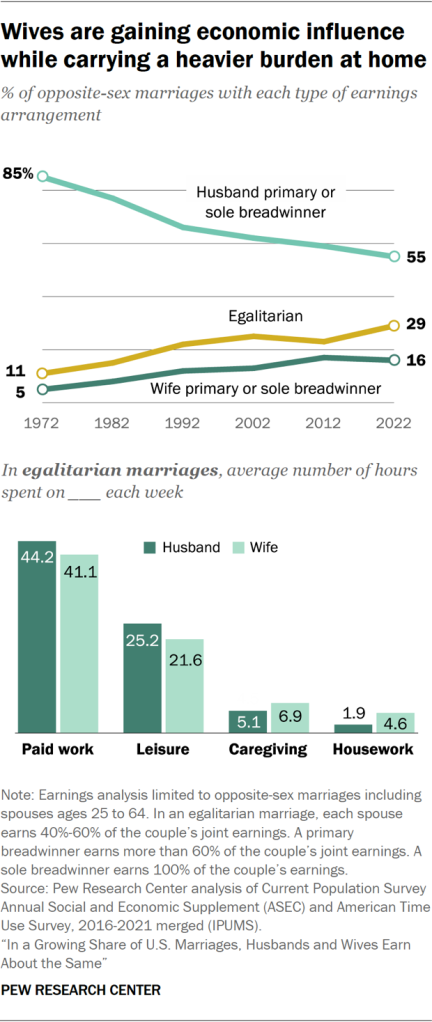
But in "egalitarian marriages," wives are still spending more than double the amount of time on housework than their husbands (4.6 hours per week for women vs. 1.9 hours per week for men), and almost two hours more per week on caregiving, including tending to children.
Husbands, meanwhile, spend roughly three hours more per week than their wives on paid work, and three and a half hours more on leisure activities.

Women leaders switch jobs at record rates as they demand better from their workplaces
"We've seen a narrowing of the gap over the years with men taking on more hours of housework and childcare as more women have gone into the workplace," says Parker.
"But that imbalance — we still see it today. It's definitely not equal."
An imbalance rooted in attitudes about where women and men belong
That can partly be blamed on attitudes and expectations about the roles of men and women at work and home, Parker says.
More than half (57%) of the 5,152 people Pew surveyed said society puts more stock in what men do at work. Only 7% said they think society values what men do at home more.
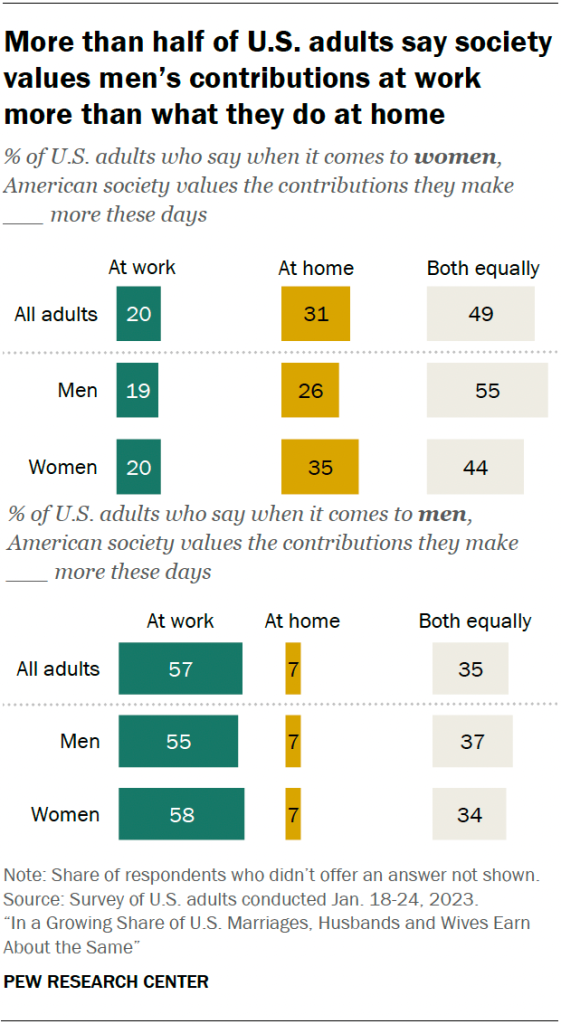
Meanwhile, only 20% of respondents said society values what women do at work more, whereas 31% said society values women's contributions at home more. (The remaining share said society values contributions to work and home equally.)
Younger Americans were the most likely to say that the contributions women make at home are valued more by society.
"They're almost more cynical about it," says Parker, noting older Americans are more likely to say society values women's contributions in both spheres equally.

Planet Money
Women now dominate the book business. why there and not other creative industries.
"Maybe they've witnessed the change over their lifetime," she says. "Whereas for young people — they might just see the imbalance now, but they haven't lived through the arc of advancements women have made in the workplace."
The new head of the Institute for Women's Policy Research says that she's heartened by the increasing attention being given to persistent imbalances in American marriages.
"I think that in the past, there was an assumption that there were certain roles that you play, and that's what women do, whether you make more or make less," says Daisy Chin-Lor, who herself earned as much as — and then more than — her husband during her long corporate career, and still carried a heavier workload at home.
"In today's world, I see my son taking much more of an active role in being a parent because he wants to, because he can."
Most Americans believe children do well when mom and dad focus equally on work and home
A broad majority of survey participants — 77% — said children of working parents are better off when both mom and dad focus equally on work and home.
Only 1 in 5 said children are better off when dad is more focused on his job and mom is more focused on home life.
Only 1 in 50 said the reverse — that children are better off when mom is more focused on work and dad is home taking care of things.
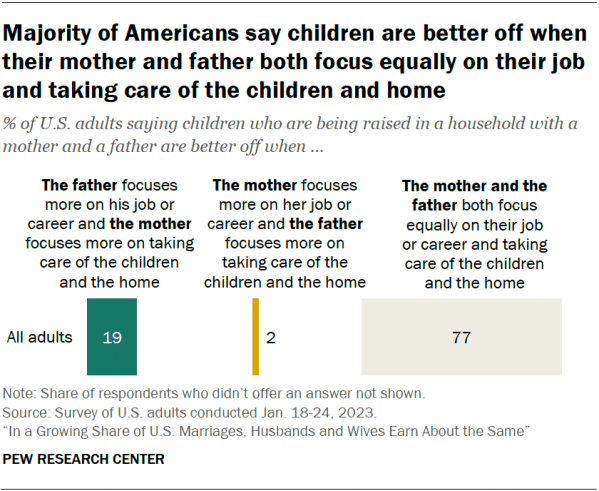
Within that data there are sizable differences in opinion depending on a respondent's political leanings. More Democrats than Republicans say it's better for both parents to be focused equally on job and home (85% of Democrats vs. 68% of Republicans), and close to 3 in 10 Republicans feel children are better off when dads are more focused on work and mom more on children and the home.
- Pew Research Center
- gender wage gap
- Voter Guide
- Crime & Courts
- Special Reports
- Faith & Values
- National Politics
- The American South
- Women of the Century
- Coronavirus
What new surveys say about Harris' support among Black Protestants, Trump abortion fallout
- New report from Lifeway Research and recent data from Pew Research Center offer new quantitative understanding of religious voters since Harris became Democratic nominee.
- Support for Trump mostly steady among white evangelical Protestant voters despite recent fallout over shifting stance on abortion. For religious voters supporting Trump, immigration is a top issue.
- Harris, whose faith background includes worshiping at historically Black Baptist congregation, sees increase in support from Black Protestants and Hispanic Catholics compared to Biden.
The new Democratic ticket for U.S. president gained support among certain religious voters, while former President Donald Trump maintains steady support among others despite recent fallout over abortion.
Two new reports, one from Lifeway Research on Tuesday and another from Pew Research Center last week , offer the first quantitative picture of religious voters’ views on the November election since Vice President Kamala Harris became the Democratic nominee instead of President Joe Biden. Just as the bid of Harris and that of her running mate, Minnesota Gov. Tim Walz, has shifted attitudes within the electorate more broadly, so has it with religious voters.
“Out of all the descriptors of pastors, their own political party preference is the best predictor of how they will vote,” said Scott McConnell, executive director of Lifeway Research, a subdivision for the publishing arm of the Nashville-based Southern Baptist Convention, in a news release. “Denominational groups often lean one way politically, but pastors must minister alongside many clergy who don’t share their political views.”
The Lifeway Research report, based on responses collected between Aug. 8 to Sept. 3, specifically surveyed pastors across different Protestant denominations. The Pew report is based on a survey from Aug. 26 to Sept. 3 of voters representing various religious traditions. Here are key takeaways:
Important context: Harris enters the race, Trump and abortion
Some of the biggest questions lately on the role of religion in the November election have been about Harris’ support among various faith groups compared to Biden and about Christians’ attitudes toward Trump amid ongoing conflict over abortion.
Abortion has been the single-most important issue for the evangelical alliance with Trump starting back in 2016. But that balance has shifted recently with Trump and his running mate, Sen. JD Vance, showing support for state autonomy in determining abortion restrictions and for in vitro fertilization, or IVF. For conservative evangelicals, who desire tighter abortion restrictions within every state and at the federal level and who are more explicitly opposing IVF , the Republican party’s shifting stance on reproductive health is an outrage and for some feels like a betrayal.
Before Biden dropped out of the race, Pew published a report in April that showed 81% of white evangelical Protestant voters and 61% of white Catholics supported Trump. In that same report, 77% of Black Protestants and 49% of Hispanic Catholics supported Biden.
Harris’ entrance into the presidential race is expected to generate greater support among non-white faith groups, especially among historically Black church communities. Harris herself has been affiliated with a historically Black congregation in San Francisco that’s aligned with the National Baptist Convention, USA, which is the nation’s largest Black Protestant denomination and is headquartered in Nashville.
Recent and related: How a new effort aims to reclaim evangelical Christian label and bridge partisan divides
New data: Harris vs. Trump
The top-level statistics from the new Lifeway Research report and most recent Pew data are:
- The Lifeway Research survey of pastors found 50% of respondents planned to vote for Trump while 24% planned to vote for Harris. Among the pastors who planned to vote for Harris, 71% were Black and 21% were white.
- In the recent Pew report on religious voters, 86% of Black Protestants and 65% of Hispanic Catholics planned to vote for Harris. Compared to that same data for Biden in Pew’s previous report, Harris saw an uptick of 9 percentage points for Black Protestant voters and 16 percentage points for Hispanic Catholics.
- Comparing the two Pew reports, overall support for Trump among white evangelical Protestant voters and white Catholics didn’t significantly change. “Otherwise, the religious dynamics of the U.S. presidential campaign look about as they did in the spring,” said Gregory Smith, senior associate director of research at Pew, in a Sept. 9 post.
On the issues: immigration, abortion, personal character
The new Lifeway Research and Pew reports show party affiliation is the factor most indicative of religious voters’ support for Harris versus Trump, meaning those voters care about a variety of issues important to Democrats and Republicans.
According to the Lifeway Research report, the top issues in determining a pastor's vote are national security, religious freedom, foreign policy, the economy, immigration, abortion and personal character. Among those issues, the recent Pew report emphasized immigration and said the importance of the issue is highest among faith groups most likely to support Trump — white evangelical Protestants and white Catholics.
“Pastors are not single-issue voters. They care deeply about where presidential candidates stand on many issues,” said McConnell in a news release about Lifeway Research’s findings.
As a result, abortion doesn’t seem to be the most dominant issue for evangelical Christians and white Catholics. It’s unclear how much of that is a response to Trump’s recent comments on abortion, which some conservative Christians have criticized as no less pro-choice than the Democrats. Pew said fewer Catholics and white Protestants rated abortion as a “very important issue” compared to more Democratic-leaning categories of religious voters, such as atheist, agnostic and Jewish voters.
Lifeway Research found 29% of pastors planning to vote for Trump said abortion is an important issue. That group was mostly comprised of older, white, male, evangelical pastors. Meanwhile, instead of abortion, pastors who were women, Black and affiliated with mainline Protestant groups said “personal character” was important to determine which candidate they vote for.
Liam Adams covers religion for The Tennessean, part of the USA TODAY Network. Reach him at [email protected] or on social media @liamsadams.
Pew Research Center examines America's big opinion shifts over last 20 years
by CORY SMITH | The National Desk

(TND) — The rise of smartphones, falling trust in national institutions, more diversity, and a 180-degree turn in public sentiment toward same-sex marriage are among the big changes in American society over the last 20 years.
The Pew Research Center published an essay that examines some of these changing attitudes as one of the ways the nonpartisan fact tank is marking its 20th anniversary.
“I think, particularly in election season, when we can all get so fixated on how public opinion changes from week to week, it's just important to take a look at the bigger scope of things,” Pew Research Center Executive Vice President Claudia Deane said Monday.
Changing views on gender and sexuality are among the biggest changes from 2004 to now.
In 2004 Pew Research Center polling, 60% of Americans opposed same-sex marriage.
By 2023, 63% of Americans supported same-sex marriage.
"In my career as a public opinion expert, the changing views of same-sex marriage over the past 20 years are among the most dramatic I've ever seen," Deane said. "Opinion literally reversed over that time period."
Similarly, views on marijuana legalization have shifted dramatically.
Just a third of American adults said marijuana should be legalized 20 years ago. By last year, support had risen to 70%.
More Americans are now “religiously unaffiliated,” according to the Pew Research Center.
They trail Protestants, who make up 41% of American adults, but make up a larger share of the population than Catholics (20%) and all other faiths (8%).
Racial and ethnic diversity has increased in the U.S. over the last couple of decades.
Asian, Hispanic and Black populations grew at faster rates than the white population between 2004 and 2022, according to the Pew Research Center.
The share of Americans who are white fell from 68% in 2004 to 59% in 2022.
The rise of the internet, smartphones and social media have been a big part of the changes we’ve seen over the last 20 years.
Just over 60% of American adults used the internet in 2004, and just 65% owned a cellphone – just a cellphone, not a smartphone specifically.
Today, over 90% are online and own a smartphone.
Traditional news organizations have struggled. Daily weekday newspaper circulation fell from around 55 million to under 21 million.
And Americans live in an increasingly fragmented news environment.
Deane said it’s increasingly hard to know where people are getting their information.
“Mainstream media has lost trust, particularly among Republicans, particularly over the past, say, decade. And there's not necessarily a lot of things that replace it,” she said. “A lot of people increasingly are getting news from social media, but people don't necessarily trust news on social media. So, I think people are struggling. People are struggling to figure out what they can believe and what's misinformation and what's real information.”
Peter Loge , the director of the School of Media and Public Affairs at George Washington University, said it’s human nature to seek out information that reinforces one’s beliefs in a complex world.
Folks are just trying to make sense of their world, he said.
And technology has allowed us to increasingly find affirmation within information echo chambers.
“What kept occurring to me in reading this research is the concept of affective polarization,” Loge said. “The rise of people increasingly identifying themselves by their political party and then condemning members of the other party because they're a member of the other party. Not because of policies they support, but just because you're one of ‘them.’ And so, it becomes a negative view of the opposition rather than a positive view of one's own position.”
Loge said he’s most troubled by the declining trust in public institutions.
Americans have increasingly polarized views on climate change, guns and abortion, the Pew Research Center said.
RELATED STORY: Drop in split-ticket voting shows just how partisan US voters have become: expert
But a growing share of Americans view both the Republican and Democratic parties as more unfavorable than favorable.
And views of Congress and the Supreme Court have become more negative over the past 20 years, according to the Pew Research Center.
Twenty years ago, about a third of Americans said they trusted the federal government to do what is right just about always or most of the time.
By last spring, just 22% said the same.
“Part of that, of course, comes out of the post-Watergate, of course Vietnam era. But you also have pundits, politicians and elected officials telling voters not to trust the courts, not to trust the police, not to trust the media, higher education, or people who don't look like them, who don't vote the same way they do,” Loge said. “And at some point, the American people listen to pundits, politicians and elected officials. If we don't have a baseline level of social trust, democracy can't function. And that for me is the most troubling.”
Deane said pollsters can increasingly predict what Americans will think of a policy simply by asking for their party ID. But that’s not always been the case, she said.
What’s the next 20 years hold in store?
Deane said the rapidly changing technological landscape might define the next era.
“We're still just trying to understand how people are using social media, what they're learning from (it) and how it's impacting them,” she said. “We do a lot of work on teens. Like there's so much we have yet to know. And yet AI is already here. So, we haven't even figured out how people are experiencing and being changed by this one technology before you have another right on its heels. So, I think the next 20 years might be about understanding that.”
Americans Who Get News Mainly on Social Media Are Less Knowledgeable and Less Engaged
And social media is now among the most common ways people—particularly young adults—get their political news.
In this Issue:
- Fall 2020 View All Other Issues
- Coping With the Pandemic
- A Look at Views on Gender Equality
- 3 Ways to Combat Addiction
- A Huge Boost for National Parks
- News on Social Media
- Confronting Ocean Plastic Pollution
- Telehealth Helps Opioid Use Disorder
- Foodborne Pathogens a Serious Threat
- In Memoriam: Arthur Edmund Pew III
- Gathering the Evidence, Making the Case
- Pandemic Threatens Black Middle-Class Gains
- Partners for a Sea Change
- Boost Chile’s COVID-19 Testing
- Return on Investment
- The History of Evaluation at Pew
- View All Other Issues
How we get our political news can make a big difference in how well-informed we are and in how likely we are to encounter—and believe—misinformation.
A Pew Research Center report published in July shows that Americans who rely primarily on social media for news—which describes about 18% of adults in the U.S.—tend to know less about the 2020 election, less about the coronavirus pandemic, and less about political news in general than people who rely on news websites, cable or network TV, radio, and print.
Those who depend on social media are also more likely than other news consumers to be exposed to made-up news, such as the conspiracy theory that powerful people planned the pandemic and invented the coronavirus in a lab, and to give credence to falsehoods.
These conclusions come from the Center’s American News Pathways project, which since last November has been exploring the connection between Americans’ news habits and their news awareness. Rather than conducting just a single poll, the news project is taking six deep dives into a pool of nearly 10,000 adults representing a demographic and geographic cross section of the nation who have agreed to periodically be surveyed.
“What the project has done is weave together where people are turning for their news—what their information and news sources are—and how that connects to their perceptions and knowledge about certain events,” says Amy Mitchell, the Center’s director of journalism research. “It’s answering the question: How do people’s sense of what’s happening in the U.S.—in the world—connect to their information sources?
“The overarching finding,” she says, “is that U.S. adults who mainly get their political news through social media tend to be less engaged with news. They follow the news less closely, and they tend to be less knowledgeable on a wide range of current events and broad political-knowledge questions about the U.S.”
Over nine months and multiple surveys, Center researchers asked respondents 29 different fact-based questions that touched on a variety of topics related to the news, from economics to President Donald Trump’s impeachment and the COVID-19 pandemic. Across the 29 questions, the average proportion that got each question right was lower among Americans who rely most on social media for political news than among those who rely most on other types of news sources (except for local TV).

The percentage of American adults who use social media for news, sometimes or often, is now at 55%, Mitchell says—up from the presidential election of 2016, when 42% of adults got at least some news from social media.
The report also found that just 8% of Americans who prefer social media for news are closely following this year’s election, compared with four times as many who get news mainly from cable TV (37%) or print (33%). Only adults who depend on local TV stations for their news are comparable to the social media group in their low attention to the election.
Nearly three-quarters of adults (71%) are active on Facebook, and about half (52%) draw at least some news from there, Mitchell says. The next most important source is YouTube. Other sources include Twitter, Instagram, LinkedIn, Snapchat, and WhatsApp.
Overall, social media ranks second among all forms of media as a pathway to news, the report says. The 18% who mainly get their news this way compares with 25% who rely on news websites, such as those managed by newspapers, news broadcasters, cable networks, and Internet-only providers.
Cable TV and local TV each are the main pathway for 16% of adults. Network TV comes in next at 13%, followed by radio at 8%. The print version of newspapers (as distinguished from their websites) runs last at 3%.
At the same time that social media usage has increased as a news platform, the credibility of traditional news sources has eroded, Mitchell says. Center research conducted last year showed that trust in The New York Times and The Washington Post , to cite two examples, fell significantly from 2014 to 2019, particularly among Republicans.
And demographic factors play a role in who goes where for news, the report says.
Nearly half of the Americans who focus on social media—48%—are under 30 years old, making them Millennials or members of Generation Z. They are, by far, the youngest group.
At the other end of the age spectrum, older Americans are much more likely to turn first to print or cable or network TV. Of adults who say that print is their most common way of getting news, 47% are 65 or older.
Partly because they’re young, people who rely primarily on social media for news have lower incomes and are less likely to hold a college degree than people in the other groups, with the exception of the local TV viewers.
“What strikes me is that the people who get most of their political news from local TV are similar in many respects to people who are getting their news from social media,” says Eugene Kiely, director of FactCheck.org, a project of the Annenberg Public Policy Center at the University of Pennsylvania that monitors the factual accuracy of national political figures and acts as a self-described “consumer advocate” for voters.
He says that he wonders if many of the social media users would be sitting on the couch watching local TV news were it not for the advent of Facebook. “There are very interesting parallels,” he says.
Kiely calls it “very concerning” that the growing cohort of social media users is paying so little attention to the Nov. 3 election, which he says makes them particularly vulnerable to the sort of deliberate misinformation that came in waves in the late stage of the 2016 presidential race.
As of June, more than a quarter of people who rely most on social media had heard “a lot” about the false story that COVID-19 was deliberately or accidentally created in a lab, and 8 in 10 had heard “a little,” the report says. Overall, their awareness of this bogus idea was higher than for any other group.
One-third of these people—36%—said they believed the virus came from a lab, and 27% said they weren’t sure. Thirty-five percent said the virus came about naturally.
The most comparable group for believing the misinformation about the virus’s origins was, again, the group that gets most of its news from local TV. Within this group, 32% said the virus originated, by mistake or on purpose, in a lab.
Users mainly of social media also had heard more than any others about two unproven theories: that vitamin C can be a protection against the virus and that the latest 5G mobile phone technology somehow is linked to the virus.
While the Americans who rely on social media as their primary news source were the most likely to both hear and believe fake news, they were the least likely (except for the local TV group) to worry that misinformation could impact the election, with only 37% saying they were very concerned about such an eventuality.
Kiely says that while the trend toward social media as a major news pathway is sure to accelerate, it’s a development that is neither good nor bad on its own. But, he adds, Americans need to better learn—and schools need to teach—media literacy.
“People should understand how news operates—what reputable news organizations do in terms of disclosing their funding, disclosing their financial ties, disclosing their staff biographies,” Kiely says. “So much of the misinformation that floats on social media is not attributed to anybody.”
Tom Infield is a longtime Philadelphia journalist and frequent contributor to Trust .

How Americans Get News Now
The gap between the share of Americans who get news online and those who get it on television is narrowing, according to the Pew Research Center.

Teens and Their Cellphones
Across the country, parents and their children have a running battle over when it’s time to put the cellphones away. “I don’t feel like I’m getting the same level of engagement when he’s on the phone for an extended period of time,” Melinda Rozsalyi, a mother in the Washington suburbs, says of her 14-year-old son, Adam.
Don’t miss our latest facts, findings, and survey results in The Rundown
MORE FROM PEW


David Bauder, Associated Press David Bauder, Associated Press
Leave your feedback
- Copy URL https://www.pbs.org/newshour/nation/majority-of-black-americans-see-racist-or-negative-depictions-in-news-media-new-study-finds
Majority of Black Americans see racist or negative depictions in news media, new study finds
NEW YORK (AP) — In a new study , Black Americans expressed broad concerns about how they are depicted in the news media, with majorities saying they see racist or negative depictions and a lack of effort to cover broad segments of their community.
Four in five Black adults say they see racist or racially insensitive depictions of their race in the news either often or sometimes, according to the Pew Research Center.
READ MORE: Bringing historical Black newspapers into the digital age, students discover their past
Three years after George Floyd’s killing triggered a racial reckoning in the news media, Pew took its first broad-based look at Black attitudes toward the media with a survey of nearly 5,000 Black adults this past winter and follow-up focus groups.
The survey found 63% of respondents saying news about Black people is often more negative than it is toward other racial or ethnic groups, with 28% saying it is about equal.
“It’s not surprising at all,” said Charles Whitaker , dean of the Medill journalism school at Northwestern University. “We’ve known both anecdotally, and through my personal experience with the Black press, that Blacks have long been dissatisfied with their coverage.
“There’s a feeling that Black Americans are often depicted as perpetrators or victims of crime, and there are no nuances in the coverage,” Whitaker said.
That attitude is reflected in the Pew study’s finding that 57% of respondents say the media only covers certain segments of Black communities, compared to 9% who say that a wide variety is depicted.
“They should put a lot more effort into providing context,” said Richard Prince, a columnist for the Journal-isms newsletter , which covers diversity issues. “They should realize that Blacks and other people of color want to be portrayed as having the same concerns as everybody else, in addition to hearing news about African American concerns.”
Advertising actually does a much better job of showing Black people in situations common to everybody, raising families or deciding where to go for dinner, he said.
WATCH: How diversity in media and entertainment affects young people
Prince said he’s frequently heard concerns about Black crime victims being treated like suspects in news coverage, down to the use of police mug shots as illustrations. He recently convened a journalist’s roundtable to discuss the lingering, notorious issue of five Black men who were exonerated after being accused of attacking a white jogger in New York’s Central Park in the 1980s.
During a time of sharp partisan differences, the study found virtually no difference in attitudes toward news coverage between Black Democrats and Republicans, said Katerina Eva Matsa, director of news and information research at Pew.
For example, 46% of Republicans and 44% of Democrats say that news coverage largely stereotyped Black people, Pew said.
Negative attitudes toward the press tended to increase with income and education levels, Matsa said. While 57% of those in lower income levels said news coverage about Black people was more negative than it was about other groups. That number jumped to 75% of wealthier respondents, the study found.
A large majority of those surveyed, young and old, expressed little confidence that things would improve much in their lifetime.
While 40% of survey participants said it was important to see Black journalists report on issues about race and racial inequality, the race of journalists wasn’t that important about general news.
Prince said it’s important for journalists to know history; he wrote on Monday about the idea of a government shutdown was raised in 1879 when former Confederates in Congress wanted to deny money to protect Black people at the polls, and how the filibuster started to prevent civil rights legislation.
READ MORE: Latinos vastly underrepresented in media, new report finds
At Northwestern, professors are trying to teach students of the importance of having a broader sense of the communities that they’re covering, Whitaker said. Medill is also a hub for solutions journalism, which emphasizes coverage of people trying to solve societal problems.
“We’re trying to get away from parachute journalism,” he said.
Prince said there was notable progress, post-Floyd, in the hiring of Black journalists into leadership roles in the media. Unfortunately, the news industry continues to contract while social media increases in importance, he said.
“We’re integrating an industry that’s shrinking,” he said.
Support Provided By: Learn more
Educate your inbox
Subscribe to Here’s the Deal, our politics newsletter for analysis you won’t find anywhere else.
Thank you. Please check your inbox to confirm.

Black-owned brewery breaking barriers and creating change in their community
Nation Jul 28
- Latest Latest
- The West The West
- Sports Sports
- Opinion Opinion
- Magazine Magazine
What American life — including organized religion — was like in 2004
Here’s how the country has changed over the past 20 years, and what the changes have meant for faith groups.

By Kelsey Dallas
This article was first published in the State of Faith newsletter . Sign up to receive the newsletter in your inbox each Monday night.
Pew Research Center, one of the survey firms I work with regularly as I cover religion in the United States, is celebrating the 20th anniversary of its launch this year.
As part of the festivities, Pew put together a list of the key changes its researchers have observed over the past two decades. Unsurprisingly, many of the highlighted shifts are connected to religion.
For example, the share of Americans who identify as “religiously unaffiliated” has surged since the center first asked about it in 2007, growing from about 16% of the U.S. adult population to 28% today.
“Religious nones are currently one of the largest religious groups in the United States. They trail Protestants, who make up 41% of U.S. adults, but make up a larger share of the population than Catholics (20%) and all other faiths (8%),” wrote Jenn Hatfield, a writer and editor for Pew, in the list of key changes.
Here are some other faith-related shifts that Pew is highlighting as it celebrates its 20th anniversary and recalls what life was like in 2004.
- Americans have lost trust in major institutions, like the Supreme Court and federal government.
The overall drop in trust has complicated the work of religious organizations. People are losing interest in joining churches as their skepticism of institutions grows.
- U.S. adults are much more online than they used to be.
The share of American adults who browse the internet has jumped from 63% in 2004 to 95% today, per Pew. That was a blessing during the height of the COVID-19 pandemic, when much socialization, including worship, needed to take place online, but it can be a curse when it fuels conspiracy theories and polarization.
- The country has become more politically polarized.
Speaking of polarization, U.S. adults have grown more divided over religion-related political issues like abortion over the past 20 years, according to Pew. In the case of abortion, the polarization primarily stems from Democrats becoming more supportive of abortion rights, while Republican views went mostly unchanged.
- Support for same-sex marriage has doubled.
In 2004, 31% of U.S. adults supported same-sex marriage. By 2023, 63% did. The surge in support has fueled a surge in legal protections for members of the LGBTQ community, which has led to some high-profile religious freedom lawsuits.

Fresh off the press
FBI investigating new assassination attempt against Trump; suspect detained
What Patrick Mahomes said about presidential endorsements
Why people prayed outside the Supreme Court last week
What Kamala Harris said about faith and abortion during the presidential debate
These religious voters like Harris more than Biden
‘I believe in the power of prayer,’ says Aaron Rodgers in new documentary
Person of the week: Keir Starmer
Keir Starmer is the prime minister of the United Kingdom. He assumed the role in early July, becoming the first openly atheist politician to hold the office, according to Religion Unplugged .
Religion Unplugged noted that Starmer’s religious identity is notable even though disengagement from organized religion has become the norm in the U.K.
As in the United States, most British politicians have continued to advertise their religious values in recent years even as their constituents have grown less interested in faith.
“Over the years, the UK has evolved into a more secular society where religious affiliation plays a less-central role in political identity. Despite this shift, atheist leaders are still a rarity on the global stage,” the article said.
Today, around 46% of people in the United Kingdom identify as Christian, while 6.5% identify as Muslim and 1.7% identify as Hindu, the U.S. State Department reports. More than one-third of people say they have no religious affiliation.
What I’m reading ...
Christian leaders in Springfield, Ohio , are playing a major role in efforts to keep the community safe amid growing national scrutiny, according to Christianity Today. Republican leaders, including former President Donald Trump, have spread misleading or outright false information about Haitian immigrants in Springfield recently while describing their immigration-related policy plans.
I have yet another Katelyn Beaty-related recommendation. Last week, I wrote about her podcast series “Tell Katelyn What to Do With Her Life,” and this week I’m writing about her blog on turning 40, which reviewed some of the key lessons she’s learned in recent years.
Emily McDowell, the mind behind my favorite stationary brand, wrote a beautiful essay honoring the life of her mother, Ruth B. McDowell, who was an internationally renowned quilter. “Her work will be remembered for its unusual and innovative use of printed fabrics. ... These unexpected, odd, and often objectively hideous prints added richness and detail to her quilts,” Emily wrote . “(My mom) explained all this, in her last weeks of life, to the nurses and doctors who rotated in and out of her hospital room: ‘A piece of fabric that looks ugly by itself sometimes turns out to be exactly what the quilt needs.’”
Odds and ends
We ordered from a new-to-us pizza place this weekend, and I was blown away by the mac’n’cheese pizza. If you ever have a chance to try that topping, do it!
Numbers, Facts and Trends Shaping Your World
Read our research on:
Full Topic List
Regions & Countries
- Publications
- Our Methods
- Short Reads
- Tools & Resources
Read Our Research On:
Who is Hispanic?
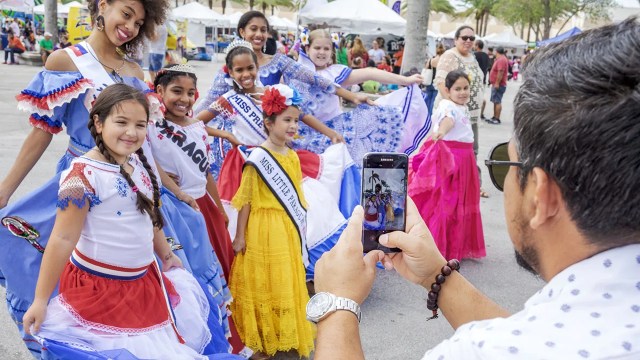
Debates over who is Hispanic have often fueled conversations about identity among Americans who trace their heritage to Latin America or Spain .
So, who is considered Hispanic in the United States today? How exactly do the federal government and others count the Hispanic population? And what role does race play in deciding who counts as Hispanic?
We’ll answer these and other common questions here.
To answer the question of who is Hispanic, this analysis draws on about five decades of U.S. Census Bureau data and about two decades of Pew Research Center surveys of Hispanic adults in the United States.
National counts of the Latino population come from the Census Bureau’s decennial census (this includes P.L. 94-171 census data ) and official population estimates . The bureau’s American Community Survey (ACS) provides demographic details such as race, country of origin and intermarriage rates. Some ACS data was accessed through IPUMS USA from the University of Minnesota.
Views of Hispanic identity draw on the Center’s National Survey of Latinos (NSL), which is fielded in English and Spanish. The survey has been conducted online since 2019, primarily through the Center’s American Trends Panel (ATP), which is recruited through national, random sampling of residential addresses. This way nearly all adults have a chance of selection. The survey is weighted to be representative of the U.S. Hispanic adult population by gender, Hispanic origin, partisan affiliation, education and other categories. Read more about the ATP’s methodology . The NSL was conducted by phone from 2002 to 2018.
Read further details on how the Census Bureau asked about race and ethnicity and coded responses in the 2020 census. Here is a full list of origin groups that were coded as Hispanic in the 2020 census.
How many Hispanics are in the U.S. today?
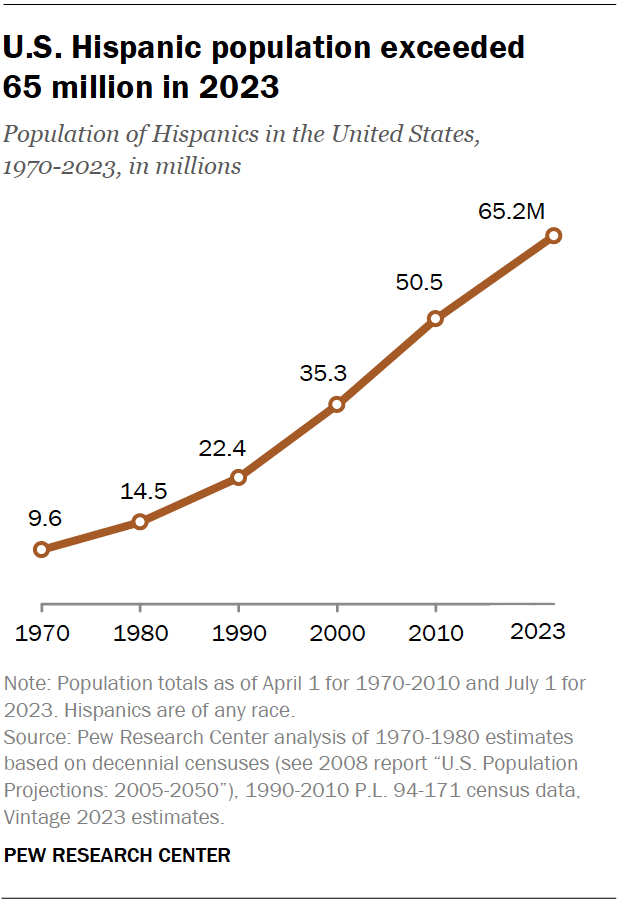
The Census Bureau estimates there were 65.2 million Hispanics in the U.S. as of July 1, 2023, a new high. They made up more than 19% of the nation’s population .
How are Hispanics identified and counted in government surveys, public opinion polls and other studies?
Before diving into the details, keep in mind that some surveys ask about Hispanic origin and race separately, following current Census Bureau practices – though these are soon to change.
One way to count Hispanics is to include those who say they are Hispanic, with no exceptions – that is, you are Hispanic if you say you are. Pew Research Center uses this approach in our surveys, as do other polling firms such as Gallup and voter exit polls .
The Census Bureau largely counts Hispanics this way, too, but with some exceptions. If respondents select only the “Other Hispanic” category and write in only non-Hispanic responses such as “Irish,” the Census Bureau recodes the response as non-Hispanic.
However, beginning in 2020 , the bureau widened the lens to include a relatively small number of people who did not check a Hispanic box on the census form but answered the race question in a way that implied a Hispanic background. As a result, someone who answered the race question by saying that they are “Mexican” or “Argentinean” was counted as Hispanic, even if they did not check the Hispanic box.
From the available data, the exact number of respondents affected by this change is difficult to determine. But it appears to be about 1% of Hispanics or fewer, according to a Pew Research Center analysis of U.S. Census Bureau data.
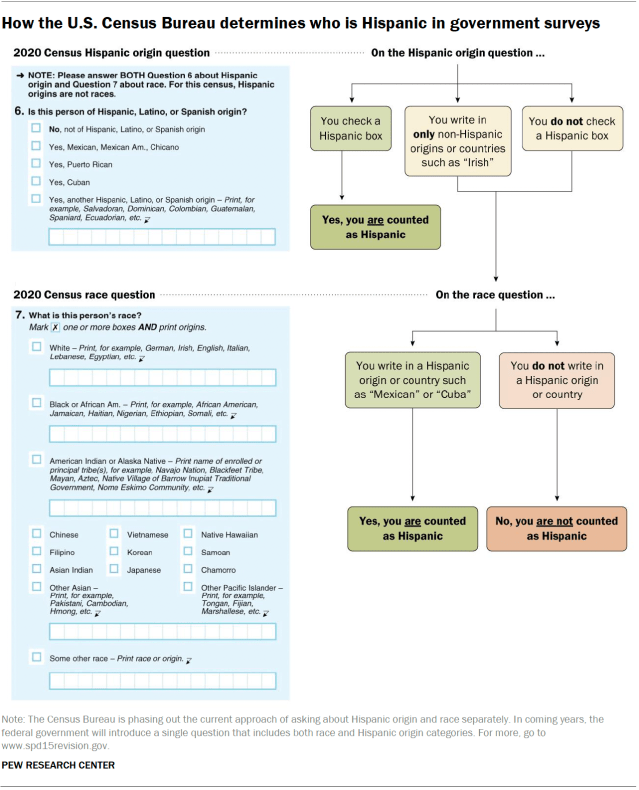
How do Hispanics identify their race in Census Bureau surveys?
In the eyes of the Census Bureau, Hispanics can be of any race, because “Hispanic” is an ethnicity and not a race. However, this distinction is subject to debate . A 2015 Center survey found that 17% of Hispanic adults said being Hispanic is mainly a matter of race, while 29% said it is mainly a matter of ancestry. Another 42% said it is mainly a matter of culture.
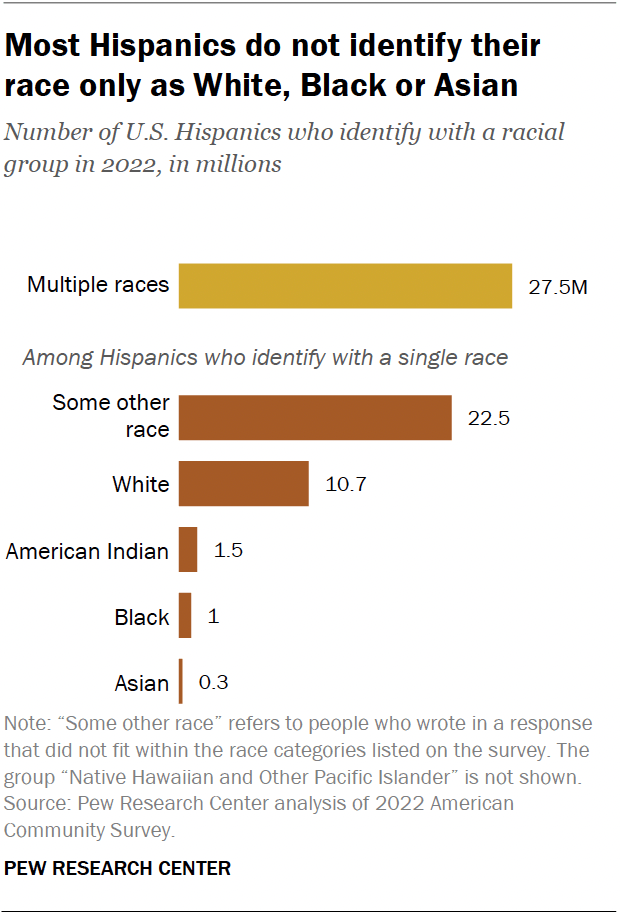
Nonetheless, the Census Bureau’s 2022 American Community Survey (ACS) provides the self-reported racial identity of Hispanics: 22.5 million single-race Hispanics identified only as “some other race.” This group mostly includes those who wrote in a Hispanic origin or nationality as their race. Another 10.7 million identified as White. Fewer Hispanics identified as American Indian (1.5 million), Black (1.0 million) or Asian (300,000).
Multiracial Hispanics
Another roughly 27.5 million Hispanics identified as more than one race in 2022, up from just 3 million in 2010.
Growth in the number of multiracial Hispanics comes primarily from those who identify as White and “some other race.” That population grew from 1.6 million to 24.9 million between 2010 and 2022. The number of Hispanics who identify as White and no other race declined from 26.7 million to 10.7 million.
The sharp increase in multiracial Hispanics could be due to several factors, including changes to the census form introduced in 2020 that added more space for written responses to the race question and growing racial diversity among Hispanics. This explanation is supported by the fact that almost 25 million of the Hispanics who identified as two or more races in 2022 were coded as “some other race” (and wrote in a response) and one of the specific races (such as Black or White). About 2.6 million Hispanics identified with two or more of the five major races offered in the census.
Changes for the 2030 census
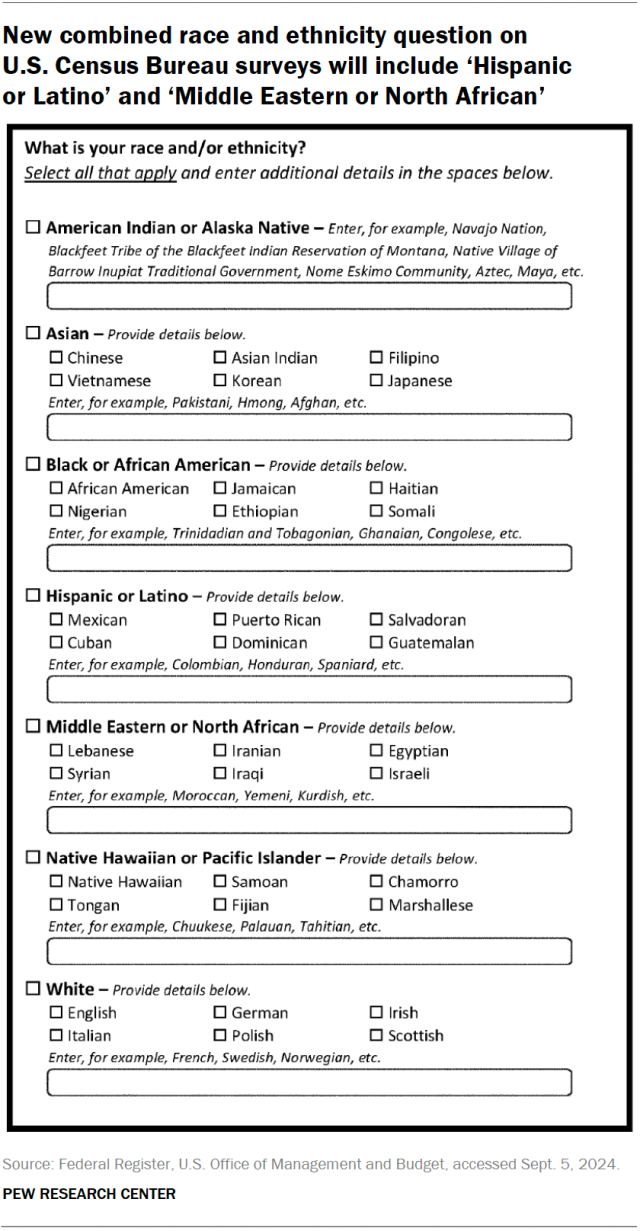
The 2030 census will combine the race and ethnicity questions , a change that other federal surveys will implement in coming years. The new question will add checkboxes for “Hispanic or Latino” and “Middle Eastern or North African” among other race groups long captured in Census Bureau surveys.
Officials hope the changes will reduce the number of Americans who choose the “Some other race” category, especially among Hispanics . However, it’s worth noting that public feedback has raised a variety of concerns, including that combining the race and ethnicity questions could lead to an undercount of the nation’s Afro-Latino population .
Is there an official definition of Hispanic or Latino?
In 1976, Congress passed a law that required the government to collect and analyze data for a specific ethnic group: “Americans of Spanish origin or descent.” That legislation defined this group as “Americans [who] identify themselves as being of Spanish-speaking background and trace their origin or descent from Mexico, Puerto Rico, Cuba, Central and South America, and other Spanish-speaking countries.” This includes around 20 Spanish-speaking nations from Latin America and Spain itself, but not Portugal or Portuguese-speaking Brazil.
To implement this law, the U.S. Office of Management and Budget (OMB) developed Statistical Policy Directive No. 15 (SPD 15) in 1977, then revised it in 1997 and again in March 2024. In the most recent revision, OMB updated racial and ethnic definitions when it announced the combined race and ethnicity question. The current definition of “ Hispanic or Latino ” is “individuals of Mexican, Puerto Rican, Salvadoran, Cuban, Dominican, Guatemalan, and other Central or South American or Spanish culture or origin.”
The Census Bureau first asked everybody in the U.S. about Hispanic ethnicity in 1980. But it made some efforts before then to count people who today would be considered Hispanic. The Census Bureau also has a long history of changing labels and shifting categories . In the 1930 census, for example, the race question had a category for “Mexican.”
The first major attempt to estimate the size of the nation’s Hispanic population came in 1970 and prompted widespread concerns among Hispanic organizations about an undercount. A portion of the U.S. population (5%) was asked if their origin or descent was from the following categories: “Mexican, Puerto Rican, Cuban, Central or South American, Other Spanish” or “No, none of these.”
This approach indeed undercounted about 1 million Hispanics. Many second-generation Hispanics did not select one of the Hispanic groups because the question did not include terms like “Mexican American.” The question wording also resulted in hundreds of thousands of people living in the Central or Southern regions of the U.S. being mistakenly included in the “Central or South American” category.
By 1980, the current approach – in which someone is asked if they are Hispanic – had taken hold, with some changes to the question and response categories since then. In 2000, for example, the term “Latino” was added to make the question read, “Is this person Spanish/Hispanic/Latino?”
What’s the difference between Hispanic and Latino?
“Hispanic” and “Latino” are pan-ethnic terms meant to describe – and summarize – the population of people of that ethnic background living in the U.S. In practice, the Census Bureau often uses the term “Hispanic” or “Hispanic or Latino.”
Some people have drawn sharp distinctions between these two terms . For example, some say that Hispanics are from Spain or from Spanish-speaking countries in Latin America, which matches the federal definition, and Latinos are people from Latin America, regardless of language. In this definition, Latinos would include people from Brazil (where Portuguese is the official language) but not Spain or Portugal.
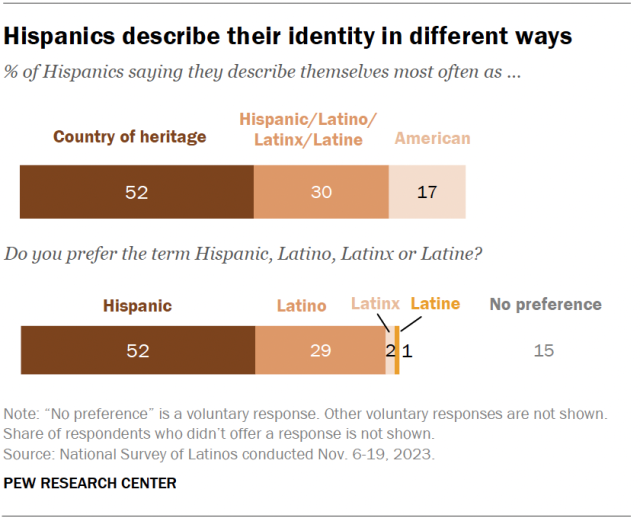
Pan-ethnic labels like Hispanic and Latino, though widely used, are not universally embraced by the population being labeled. Our 2023 National Survey of Latinos shows a preference for other terms to describe identity: 52% of respondents most often described themselves by their family’s country of origin, while 30% used the terms Hispanic, Latino, Latinx or Latine, and 17% most often described themselves as American.
The 2023 survey also finds varying preferences for pan-ethnic labels: 52% of Hispanics prefer to describe themselves as Hispanic, 29% prefer Latino, 2% prefer Latinx, 1% prefer Latine and 15% have no preference.
What is ‘Latinx’ and who uses it?
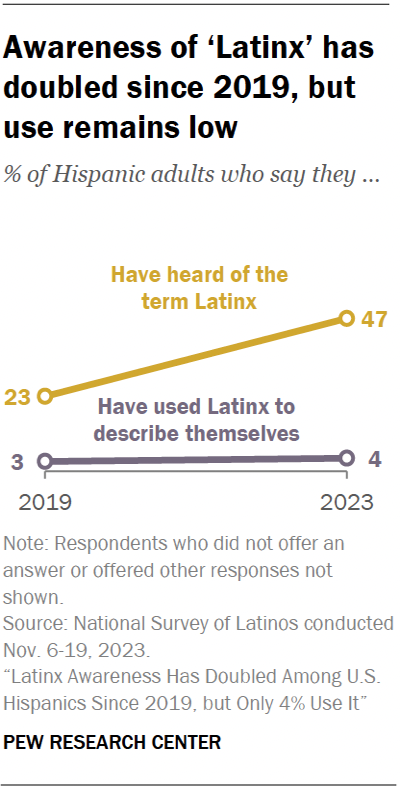
Latinx is a pan-ethnic identity term that has emerged in recent years as an alternative to Hispanic and Latino. Some news and entertainment outlets, corporations , local governments and universities use it to describe the nation’s Hispanic population.
However, its popularity has brought increased scrutiny in the U.S. and abroad . Some critics say it ignores the gendered forms of Spanish language, while others see Latinx as a gender- and LGBTQ+-inclusive term . Adding to the debate, some state lawmakers favor banning the use of the term entirely in government documents; Arkansas has done so already .
A 2023 survey found that awareness of Latinx has doubled among U.S. Hispanics since 2019, with growth across all major demographic subgroups. Still, the share of Hispanic adults who use Latinx to describe themselves is statistically unchanged: In 2023, 4% said they use it, compared with 3% in 2019.
Latinx is also broadly unpopular among Latinos who know the term. Three-in-four Latino adults who are aware of Latinx say the term should not be used to describe Hispanics or Latinos.
The emergence of Latinx coincides with a global movement to introduce gender-neutral nouns and pronouns into many languages that have traditionally used male or female constructions. In the U.S., Latinx first appeared more than a decade ago, and it was added to a widely used English dictionary in 2018.
What is ‘Latine’ and who uses it?
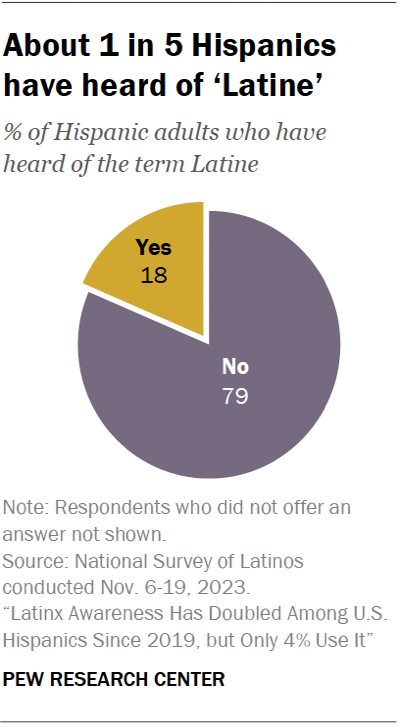
Latine is another pan-ethnic term that has emerged in recent years. Our 2023 survey found that 18% of U.S. Hispanics have heard of the term.
Similar to familiarity with Latinx, awareness of Latine varies by age, education and sexual orientation. Among Latinos, awareness of Latine is highest among those ages 18 to 29 (22%), college graduates (24%) and lesbian, gay and bisexual adults (32%).
How do factors like language, parental background and last name affect whether someone is considered Hispanic?
Many U.S. Hispanics have an inclusive view of what it means to be Hispanic:
- 78% of Hispanic adults said in a 2022 Center survey that speaking Spanish is not required to be considered Hispanic. English-dominant Hispanics were more likely than Spanish-dominant Hispanics to say so (93% vs. 64%).
- 33% of Hispanic adults said in a 2019 survey that having two Hispanic parents is not an essential part of what being Hispanic means to them. Another 34% said it was important but not essential and 32% said it was essential.
- 84% of Hispanic adults said in a 2015 survey that having a Spanish last name is not required.
Views of Hispanic identity may change in the coming decades as broad societal changes, such as rising intermarriage rates, produce an increasingly diverse and multiracial U.S. population .
Today, many Hispanic families include people who are not Hispanic:
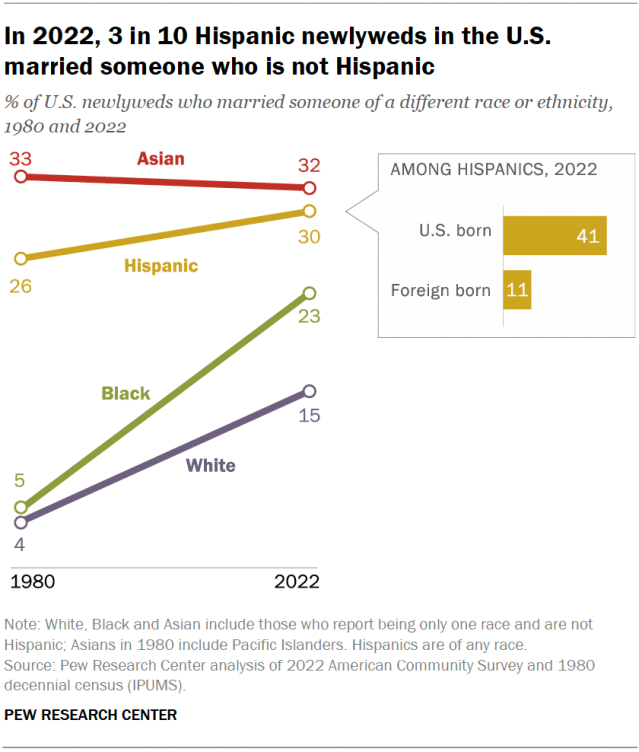
Spouses: Among all married Hispanics in 2022, 22% had a spouse who is not Hispanic. And in a 2023 Center survey , 27% of Hispanics with a spouse or partner said their spouse or partner is not Hispanic.
Newlyweds: In 2022, 30% of Hispanic newlyweds married someone who is not Hispanic. Among them, 41% of those born in the U.S. married someone who is not Hispanic, compared with 11% of immigrant newlyweds, according to an analysis of ACS data.
Parents: Our 2015 survey found that 15% of U.S. Hispanic adults had at least one parent who is not Hispanic. This share rose to 29% among the U.S. born and 48% among the third or higher generation – those born in the U.S. to parents who were also U.S. born.
What role does skin color play in whether someone is Hispanic?
In surveys like those from the Census Bureau, skin color does not play a role in determining who is Hispanic or not. However, as with race, Latinos can have many different skin tones. A 2021 Center survey of Latino adults showed respondents a palette of 10 skin colors and asked them to choose which one most closely resembled their own.
Latinos reported having a variety of skin tones, reflecting the diversity within the group. Eight-in-ten Latinos selected one of the four lightest skin colors. By contrast, only 3% selected one of the four darkest skin colors.
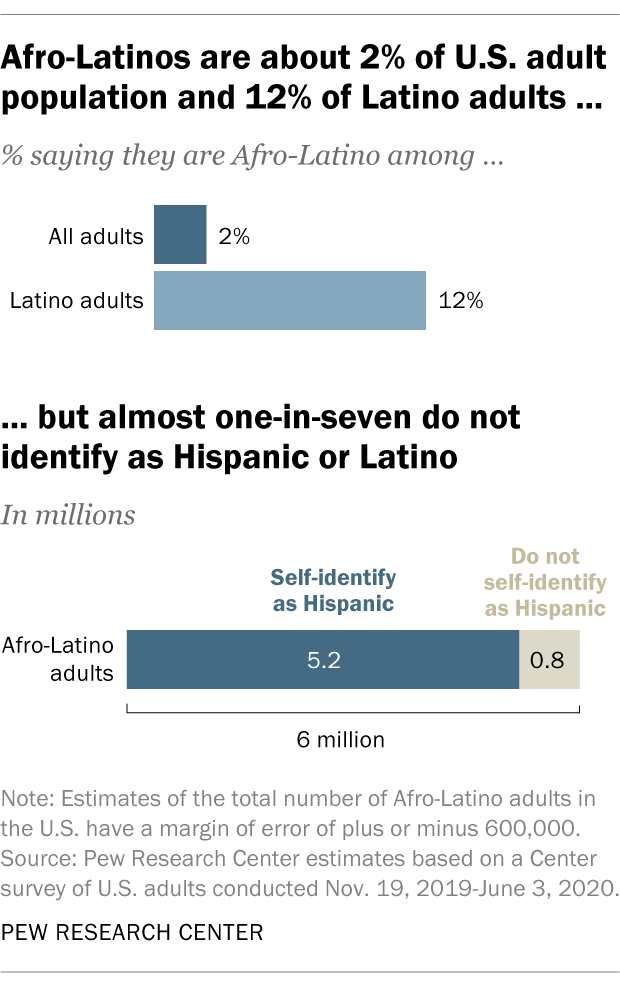
A majority of Latino adults (57%) say skin color shapes their daily life experiences at least somewhat. Similar shares say having a lighter skin color helps Latinos get ahead in the U.S. (59%) and that having a darker skin color hurts Latinos’ ability to get ahead (62%).
Are Afro-Latinos Hispanic?
Afro-Latino identity is distinct from and can exist alongside a person’s Hispanic identity. Afro-Latinos’ life experiences are shaped by race, skin tone and other factors in ways that differ from other Hispanics. While most Afro-Latinos identify as Hispanic or Latino, not all do, according to our estimates based on a survey of U.S. adults conducted in 2019 and 2020.
In 2020, about 6 million Afro-Latino adults lived in the U.S., making up about 2% of the U.S. adult population and 12% of the adult Latino population. About one-in-seven Afro-Latinos – an estimated 800,000 adults – do not identify as Hispanic.
Are Brazilians, Portuguese, Belizeans and Filipinos considered Hispanic?
Officially, Brazilians are not considered Hispanic or Latino because the federal government’s definition applies only to those of “Spanish culture or origin.” In most cases, people who report their Hispanic or Latino ethnicity as Brazilian in Census Bureau surveys are later recategorized – or “back coded” – as not Hispanic or Latino . The same is true for people with origins in Belize, the Philippines and Portugal.
An error in how the Census Bureau processed data from a 2020 national survey omitted some of this coding and provided a rare window into how Brazilians (and other groups) living in the U.S. view their identity.
In 2020, at least 416,000 Brazilians — more than two-thirds of Brazilians in the U.S. — described themselves as Hispanic or Latino on the ACS and were mistakenly counted that way. Only 14,000 Brazilians were counted as Hispanic in 2019, and 16,000 were in 2021.
The large number of Brazilians who self-identified as Hispanic or Latino highlights how their view of their own identity does not necessarily align with official government definitions. It also underscores that being Hispanic or Latino means different things to different people .
How many people with Hispanic ancestry do not identify as Hispanic?
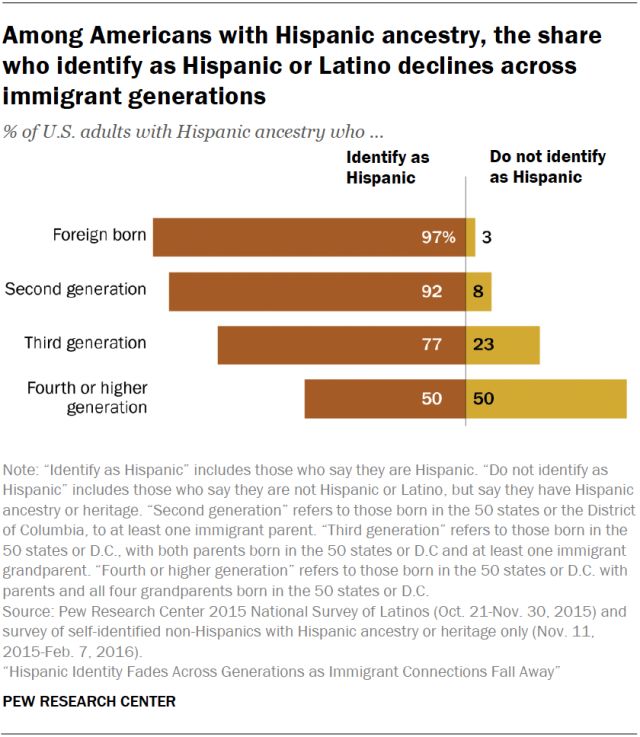
Of the 42.7 million adults with Hispanic ancestry living in the U.S. in 2015, an estimated 5 million people, or 11%, said they do not identify as Hispanic or Latino , according to a 2015-16 Center survey. These people aren’t counted as Hispanic in our surveys.
Notably, Hispanic self-identification varies across immigrant generations. Among immigrants from Latin America, nearly all identify as Hispanic. But by the fourth generation, only half of people with Hispanic heritage in the U.S. identify as Hispanic.
Note: This is an update of a post originally published on May 28, 2009.
- Hispanic/Latino Identity
- Racial & Ethnic Identity

Mark Hugo Lopez is director of race and ethnicity research at Pew Research Center .

Jens Manuel Krogstad is a senior writer and editor at Pew Research Center .
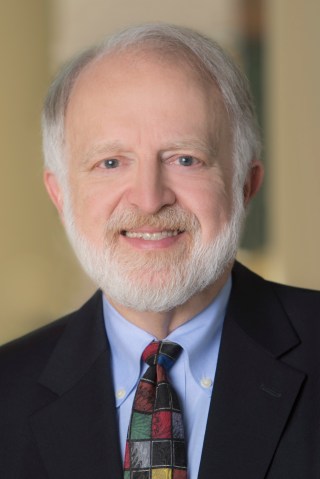
Jeffrey S. Passel is a senior demographer at Pew Research Center .
Latinx Awareness Has Doubled Among U.S. Hispanics Since 2019, but Only 4% Use It
A majority of latinas feel pressure to support their families or to succeed at work, key facts about u.s. latinos for national hispanic heritage month, latinos’ views of and experiences with the spanish language, 11 facts about hispanic origin groups in the u.s., most popular.
901 E St. NW, Suite 300 Washington, DC 20004 USA (+1) 202-419-4300 | Main (+1) 202-857-8562 | Fax (+1) 202-419-4372 | Media Inquiries
Research Topics
- Email Newsletters
ABOUT PEW RESEARCH CENTER Pew Research Center is a nonpartisan, nonadvocacy fact tank that informs the public about the issues, attitudes and trends shaping the world. It does not take policy positions. The Center conducts public opinion polling, demographic research, computational social science research and other data-driven research. Pew Research Center is a subsidiary of The Pew Charitable Trusts , its primary funder.
© 2024 Pew Research Center

IMAGES
VIDEO
COMMENTS
The latest Pew Research Center survey, conducted Aug. 26-Sept. 2, 2024, finds that majorities of registered voters in three key religious groups say they would vote for Trump or lean toward doing so if the election were today: 82% of White evangelical Protestants; 61% of White Catholics; 58% of White nonevangelical Protestants
Pew Research Center conducted this study to understand Americans' views of the 2024 presidential election campaign. For this analysis, we surveyed 9,720 adults - including 8,044 registered voters - from Aug. 26 to Sept. 2, 2024. Everyone who took part in this survey is a member of the Center ...
Following Robert F. Kennedy's recent exit from the presidential race, Vice President Kamala Harris and former President Donald Trump are tied among registered voters at 49% each.. Harris and Trump also remain at near parity in strength of support, with about six-in-ten of each candidate's supporters backing them strongly.Harris backers continue to support her more strongly than Biden's ...
By Char Adams. The Pew Research Center has revised a report after it received criticism for saying a majority of Black Americans believe "racial conspiracy theories" about U.S. institutions ...
Pew Research Center; About. Trust Magazine May 29, 2024. ... Editor's note: This report was updated on Oct. 23, 2020, to include a more comprehensive list of contributors and sources, and to add a link to the recently published article in the journal Science.
Pew Research Center has deep roots in U.S. public opinion research. Launched as a project focused primarily on U.S. policy and politics in the early 1990s, the Center has grown over time to study a wide range of topics vital to explaining America to itself and to the world. ... Signature Reports. report Feb 22, 2024. Race and LGBTQ Issues in K ...
A new Pew Research Center report finds that in opposite-sex marriages in the U.S., women's financial contributions have grown, but they're still doing a larger share of housework and caregiving.
Amy Mitchell, Director, Journalism Research Elisa Shearer, Research Associate Hannah Klein, Communications Manager. 202.419.4372. www.pewresearch.org. RECOMMENDED CITATION. About Pew Research Center Pew Research Center is a nonpartisan fact tank that informs the public about the issues, attitude. and trends shaping the world. It.
The most recent data is from the Center's 2020 and 2021 National Public Opinion Reference Surveys (NPORS). These surveys were conducted online and by mail among a nationally ... report "How Pew Research Center Uses Its National Public Opinion Reference Survey (NPORS)." Among Protestants, born-again or evangelical Christians continue to ...
New report from Lifeway Research and recent data from Pew Research Center offer new quantitative understanding of religious voters since Harris became Democratic nominee. ... Pew published a ...
The Pew Research Center published an essay that examines changing attitudes of the last 20 years. Tue, 17 Sep 2024 11:08:49 GMT (1726571329304) Story Infinite Scroll - News3 v1.0.0 (common) ...
As public support for a TikTok ban continues to decline, many U.S. adults are skeptical or unsure such a ban will happen, according to a Pew Research Center survey conducted July 15-Aug. 4, 2024. The share of Americans who support the U.S. government banning TikTok now stands at 32%. That's down from 38% in fall 2023 and 50% in March 2023.
A Pew Research Center report published in July shows that Americans who rely primarily on social media for news—which describes about 18% of adults in the U.S.—tend to know less about the 2020 election, less about the coronavirus pandemic, and less about political news in general than people who rely on news websites, cable or network TV, radio, and print.
The Pew Research Center conducted its first study of Black attitudes toward news coverage three years after a racial reckoning in the media prompted by the police killing of George Floyd.
Pew Research Center, one of the survey firms I work with regularly as I cover religion in the United States, is celebrating the 20th anniversary of its launch this year. As part of the festivities, Pew put together a list of the key changes its researchers have observed over the past two decades. Unsurprisingly, many of the highlighted shifts ...
Support for a U.S. TikTok ban continues to decline, and half of adults doubt it will happen. The share of Americans who support the U.S. government banning TikTok now stands at 32%, down from 38% in fall 2023 and 50% in March 2023. short readsAug 30, 2024.
The Pew Research Center recently published a report that noted that the majority of American workers are employed in the service sector. Specifically, "Among the major service-industry sectors, the biggest was trade, transportation, and utilities (27.8 million workers), followed by education and health services (24.3 million), professional and business services (21.5 million), and leisure and ...
Here's a look back at the past year through 15 of our most striking research findings, which cover these topics and more. These findings represent just a sample of the Center's research publications this year. Today, roughly four-in-ten Americans (41%) say none of their purchases in a typical week are paid for using cash, a July survey ...
The Pew Research Center recently published a report that noted that the majority of American workers are employed in the service sector. Specifically, "Among the major service-industry sectors, the biggest was trade, transportation, and utilities (27.8 million workers), followed by education and health services (24.3 million), professional and business services (21.5 million), and leisure and ...
Pew Research Center has a long history of studying technology adoption trends and the impact of digital technology on society. This report focuses on American adults' experiences with and attitudes about their internet and technology use during the COVID-19 outbreak. For this analysis, we surveyed 4,623 U.S. adults from April 12-18, 2021.
As 2021 draws to a close, here are some of Pew Research Center's most striking research findings from the past year. These 15 findings cover subjects ranging from extreme weather to the COVID-19 pandemic and ongoing demographic shifts in the United States. And they represent just a small slice of the year's full list of research publications.
In a pattern consistent with past Center studies on social media use, there are some stark age differences. Some 84% of adults ages 18 to 29 say they ever use any social media sites, which is similar to the share of those ages 30 to 49 who say this (81%). By comparison, a somewhat smaller share of those ages 50 to 64 (73%) say they use social ...
As 2020 draws to a close, here are 20 striking findings from Pew Research Center's studies this year, covering the pandemic, race-related tensions, the presidential election and other notable trends that emerged during the year. Since the very beginning of the U.S. coronavirus outbreak, Democrats have been far more likely than Republicans to ...
About half of U.S. adults (52%) lived in middle-income households in 2022, according to a Pew Research Center analysis of the most recent available government data. Roughly three-in-ten (28%) were in lower-income households and 19% were in upper-income households. Our calculator below, updated with ...
Alternatives to the pan-ethnic labels Hispanic and Latino emerge every so often. 5 But none have been widely adopted or embraced by the population they are meant to describe. And few Hispanic adults have even heard of some of them. "Latinx" is a recent pan-ethnic label that emerged to describe the U.S. population that traces its roots to Latin America and Spain.
The Census Bureau first asked everybody in the U.S. about Hispanic ethnicity in 1980. But it made some efforts before then to count people who today would be considered Hispanic. The Census Bureau also has a long history of changing labels and shifting categories.In the 1930 census, for example, the race question had a category for "Mexican."